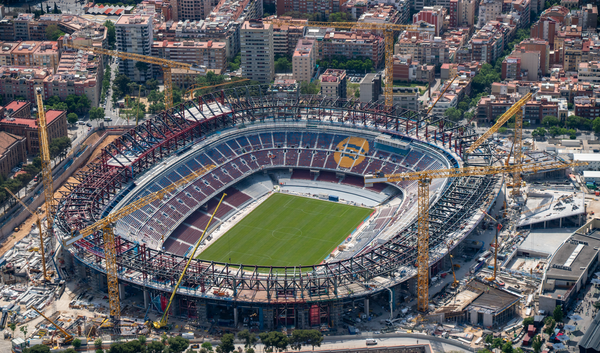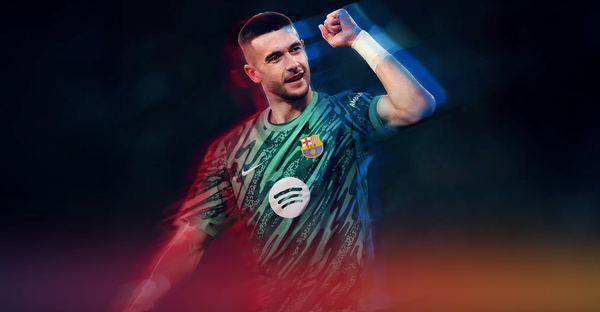Ansu Fati : The search for the new Barcelona no.9
Ansu Fati has elite instincts as a number 9, exploiting space between defenders with well-timed runs. coupled with clinical finishing
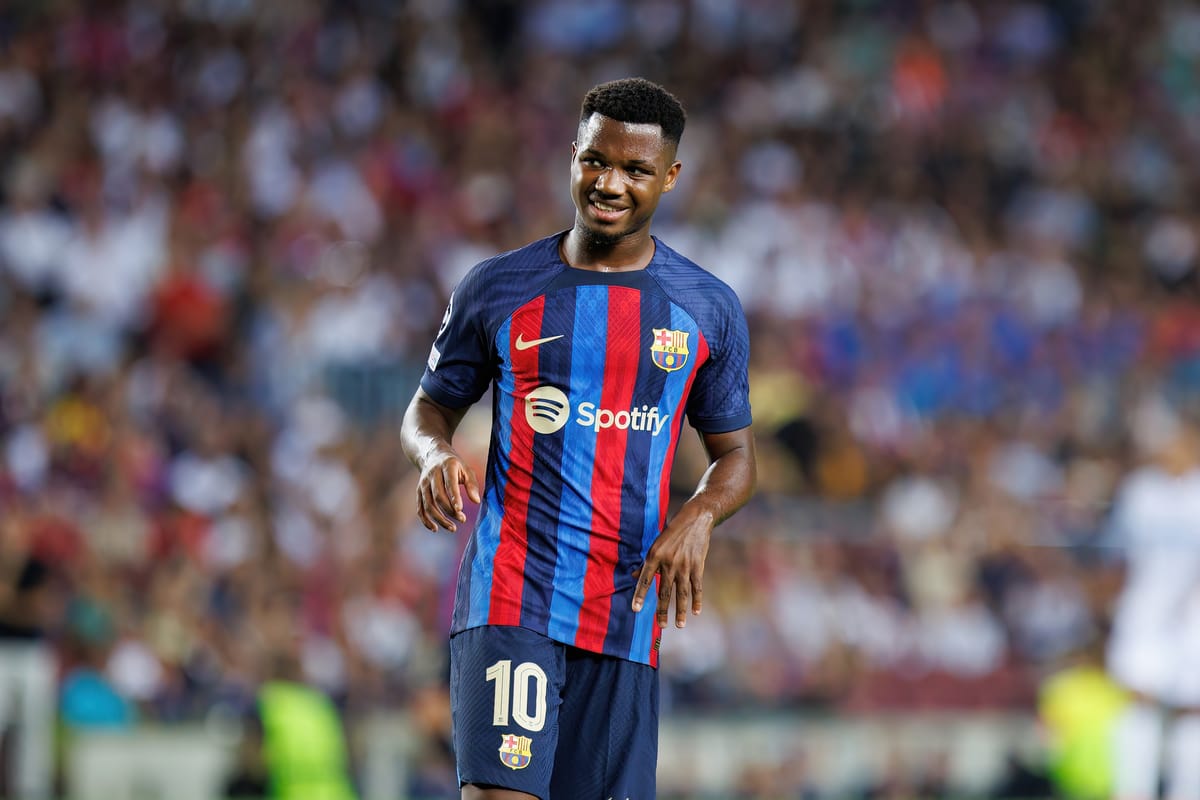
The word on the street is Barcelona are on a hunt for a marquee number 9 signing in the upcoming summer transfer window. Borussia Dortmund’s Erling Braut Haaland, of course, tops their wish list. But that’s not a surprise. The young Norwegian prodigy is destined to mark the scene for the next decade alongside the Madrid-bound Kylian Mbappé so naturally, Barça want to be a part of it. Haaland, however, just like his Paris Saint-Germain counterpart, isn’t going to be cheap.
His release clause standing at only €75M is nothing but a mirage; an illusion signalling availability. In reality, though, the cost of that transaction would well and truly wreck both the bank and Barcelona’s still fragile wage bill. But, some things are worth investing in. Speaking of investments, however, Blaugrana’s best-ever investments have always come and always will come from within. Trusting in our own assets as opposed to seeking glory elsewhere is the true motto of the club. It’s what makes Barcelona special, among other things.
But the club has never been that big on producing prolific number 9s. Midfielders, sure. Even amazing ball-playing centre-backs too. But rarely elite centre-forwards, especially those of the more traditional elk. The new generation led by the likes of Victor Barbera or Hugo Alba may signal a shift but as of right now, the club is still looking outside its backyard in search of a marquee striker.
In comes Ansu Fati, the poster boy of the club for years to come. The youngster, riddled with injuries of course, hasn’t been a prominent figure in recent times but is looking to make a huge comeback this month. Fati as we know him, however, is not a striker; he’s a left inside-forward at best. But does that mean he’s unsuitable for the role?
It is my belief that he has all the attributes to become a great striker. So in this piece, I’ll dissect them in detail and see whether he could indeed be the solution to Barcelona’s centre-forward hunt.
Let’s begin.
Setting the parameters
Before getting into Fati’s skill set and why I believe it’s highly translatable to a centre-forward position, we first need to establish the ground rules. Positions and profiles are some of the fundamental aspects of football. However, we are somewhat limited in the way we look and interact with them.
For instance, when looking for a new striker, we often limit our search to strikers only. It’s only natural. But is that the most efficient way of doing it? Is there a particular reason players deployed in other positions couldn’t perform the role of a striker, provided they indeed have the qualities needed to succeed? This is the premise of this piece of analysis.
Even though he was a striker in the academy, in the senior team Ansu Fati is a winger. But wingers, just like players in essentially any other position, can transition to a role of a centre-forward. If - and this is very important - they possess the traits to do so. But what are those traits? After some brainstorming and watching footage of the best strikers, here’s what I’ve come up with.
- Back to goal ability: involvement in central areas & high-pressure/tight marking scenarios - the timing of showing for the ball, peeling/checking away and into space you want to advance, receiving/controlling the ball (using the back foot, angle of receiving, quality of the first touch, quantity of touches needed, taking the touch towards the pass, body orientation), scanning the surroundings, physical attributes (dominating the defenders, using your frame to shield the ball, staying on your feet)
- Movement with/without the ball and in relation to others: recognising how and when to open channels, attacking space, decoy runs, the timing of runs, space occupation in relation to teammates
- Associative play: technical ability on the ball, passing/decision-making at multiple angles, link-up play, creativity
- Lethality & ball-striking: movement/separation inside the box, positioning, finishing skill/ball-striking
Elite strikers possess all of these attributes. So now, we’ll look at Fati’s arsenal to see whether he could be a candidate for a transition to a centre-forward role.
Movement in relation to others
The first aspect I want to dissect is movement. Interestingly, this is something I’ve already touched upon in my Ferran Torres analysis but it’s also very important for Fati. Elite strikers move in a way that optimises their goal-scoring chances, meaning, they get into good positions to score through their smart positioning and/or manipulating the defence’s structure.
Since that’s something I’ve explained in detail in the aforementioned Ferran piece - which you can find on the site as well - I won’t do it again here. However, the movement of strikers isn’t limited to the opposition’s penalty area. It’s where it can be most effective, yes, but the modern number 9 is far more involved across the pitch. The striker Barcelona are looking for is a profile willing to run and open channels, attack space and move according to the needs of the team.
This means that dropping towards or away from the ball is completely dependent on his teammates’ positioning and needs. Fortunately, Fati’s awareness and movement are incredibly good. This can be as simple as recognising when to attack space. For instance, below, we see Fati instantly start the run as soon as possession is recycled towards the flanks.
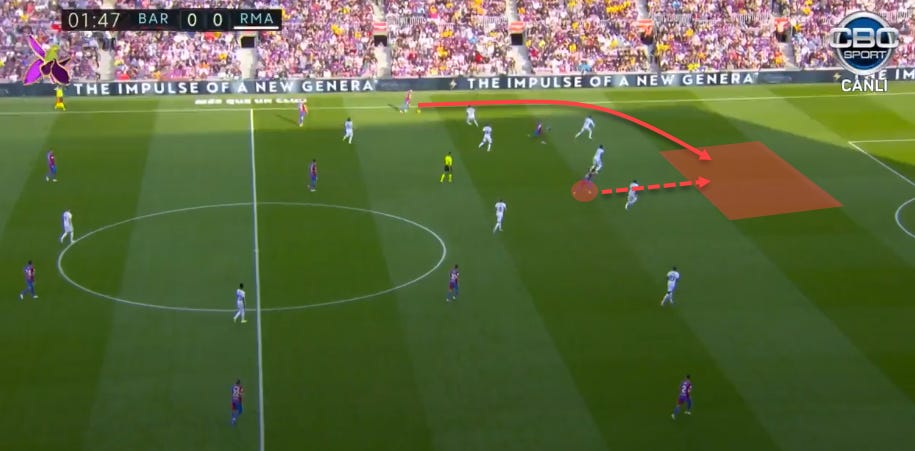
The timing is key here as he needs the dynamic superiority against the Real Madrid backline. This is also a great example of simply understanding the plan - he knows how to move in relation to his teammate’s positioning. The ball being where it is is a signal for him to start attacking space because a pass is coming shortly. Basic stuff but key nonetheless.
Understanding associative play is as important as being able to participate in it. Later on, we’ll see how good Fati can be on the ball but for now, let’s see more examples of him reacting and understanding his teammates’ actions in possession. Every action has a reaction - it’s one of the fundamental laws of motion and the same is applicable to football.
In the example below, we see Fati interchanging positions with Memphis Depay. As the Dutchman drops deep from a central position, Ansu cuts in to exploit the newfound space behind the opposition’s backline. Simple but effective.
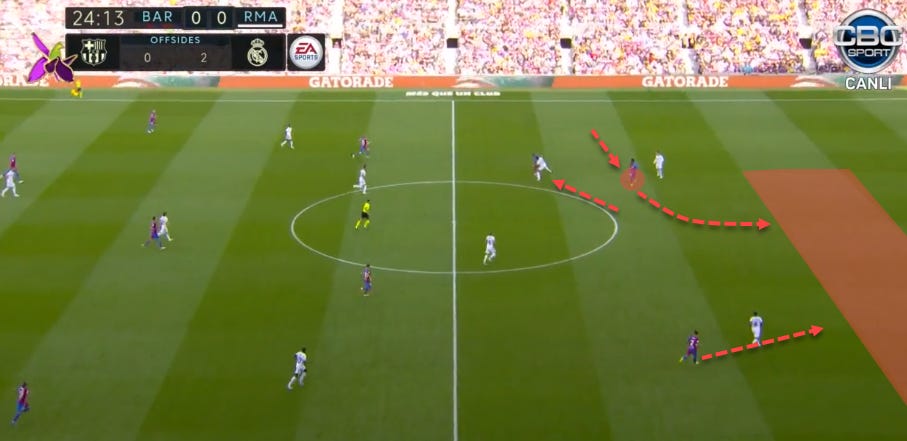
Once again, Fati has recognised where he needs to move as a result of his teammate’s repositioning. He identified the space to run into and exploited it with pace and intent. The action soon leads to a clear-cut chance in front of the goal and Fati plays a part due to his intelligent movement. But this channel was fairly obvious to begin with.
Barcelona have done well to both isolate their attacking pieces and create & exploit space soon afterwards. However, strikers, in particular, will often have to operate in much tighter spaces where channels won’t always be as obvious as this one. But Fati moves well to both exploit and create new angles for progression.
This key trait enables him to be efficient in breaking down compact blocks as well as participating in the build-up towards a goal-scoring opportunity. Below, he reacts to his teammates’ associative play, dragging the markers away and then curving the run to receive in space that was previously inaccessible.
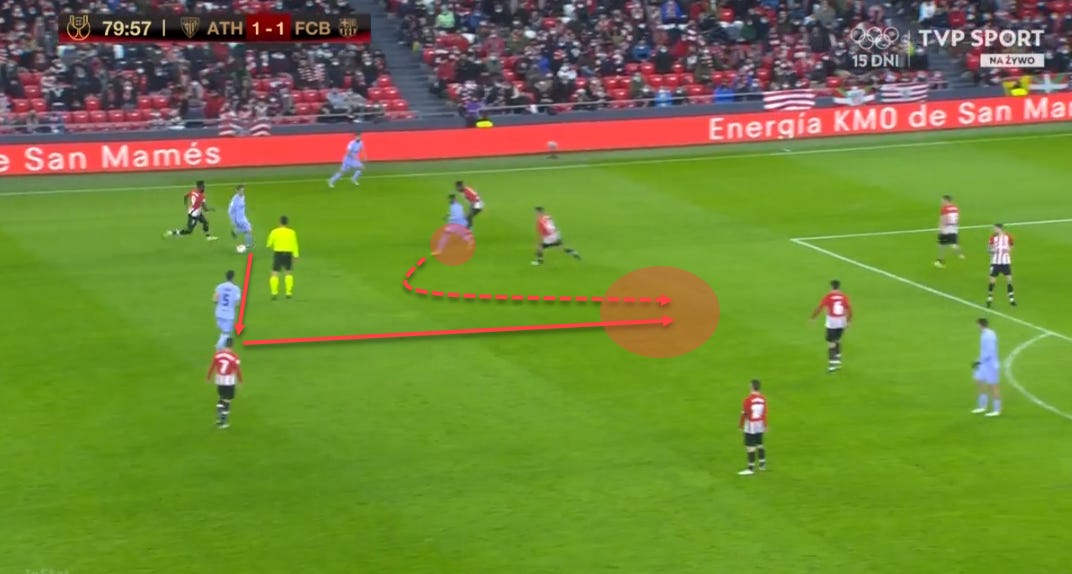
That particular sequence shows us he understands where and when to move as well as how to create and exploit space. These are key attributes of a player whose role is to operate in areas where space is often a luxury. Let’s look at some videos to further solidify the aspects of movement.
It’s very important to note that movement and association are closely related, as are most things on our checklist. So we’ll explore movement further when we get to the associative play part of the analysis. The next GIF example, however, is a long but effective one. Here, we see how Fati is constantly reacting to his teammates’ positioning and actions.

The ball is being recycled out wide? I’ll immediately attack space/box as I’m expecting a delivery. A teammate is struggling to find a progressive option? I’ll drop deep to open a channel. We’re struggling to advance up the pitch due to the opposition’s compact structure? I’ll show for the ball, receive and push up myself before combining if needed.
Fati’s awareness and subsequently, movement, are on an extremely high level. He knows there always needs to be a balance of players coming short and players moving away from the ball, as we can see in the GIF above too. Similarly, he’ll always ask for the ball but since he’s also scanning constantly, he knows when it’s viable to receive and when it is not.
And this, needless to say, is key to becoming an elite striker.
Associative and omnidirectional play
Association with the ball has become a standard aspect of any modern striker’s tool kit. It never used to be so but the modern game requires modern solutions and nowadays, link-up and build-up participation of number 9s has come to be expected at the highest level. But for a winger who’s potentially transitioning to a more central role, omnidirectional play could prove as much if not even more important.
When I was analysing Sergiño Dest’s suitability for the inverted role, I had to apply the same principles. Traditional touchline full-backs operate at more limited angles than inverted ones due to the latter’s central position. The same is true when comparing wingers to centre-forwards - the latter has to face the pitch to both of his sides while the former has the security (or the limitation) of the touchline to one of his.
But as I already alluded to, movement or rather, awareness of your surroundings, is closely related to being associative. Both require you to be in sync with your teammates and Fati is exactly that.
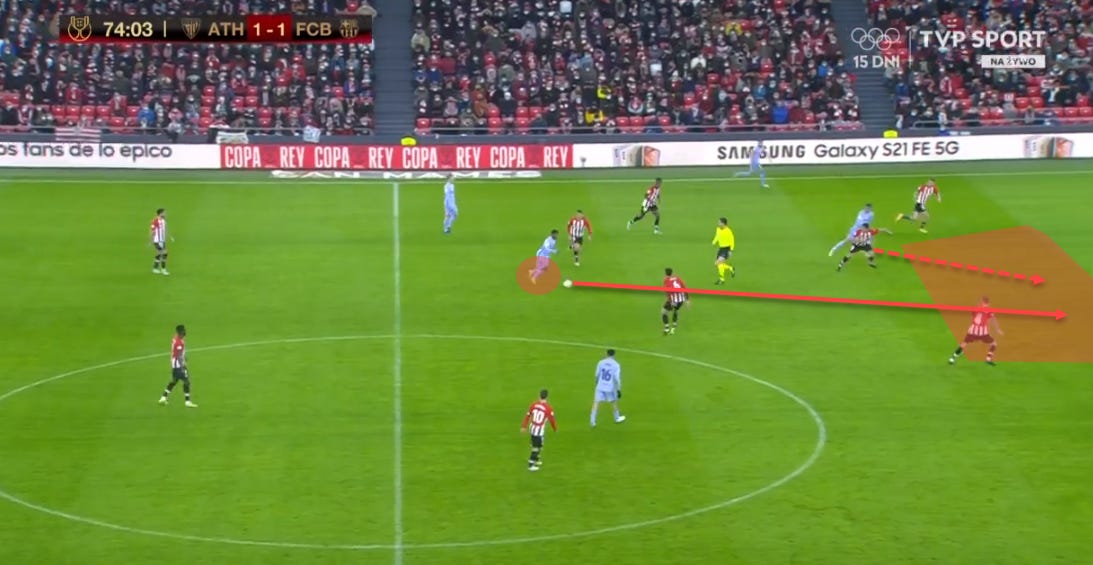
The above image is a fairly simple example of recognising where the play needs to go, timing the pass well and then executing it - the sequence may seem basic for highly creative forwards or midfielders but for Fati to be able to do it so well is impressive. However, we need to understand that this wouldn’t be his task in a more robust no.9 role. But considering he’s highly technical, excellent on the ball and loves to be highly involved, it can perhaps be expected.
More often, however, we’ll see him participate in simpler combination link-ups with the midfield or his closest teammates. And despite his technical quality, Fati isn’t always overly involved, especially when playing as the centre-forward. Looking back at his admittedly limited striker game pool, he does seem to still gravitate towards the left and play passes towards his right, favouring his dominant foot.
I wouldn’t call his pass selection limited per se but it’s also not too diverse either. Below, you can see two pass maps from his usual left-wing position (above) and two from the striker position (below).
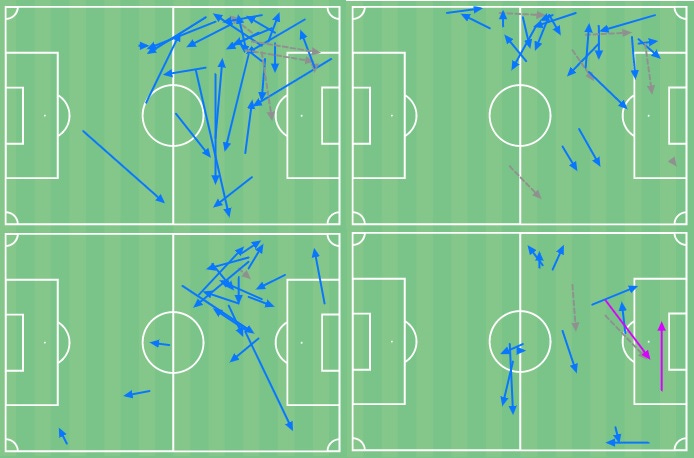
As a general rule of thumb, the difference between the two is usually minimal, although the final pass map does provide a different outlook on his pass selection. Facing the play forward opens the pitch and gives Fati more options. This can be rewarding because his technique and execution are excellent. The passes are both well-weighted and timed correctly, meaning the youngster can be quite a playmaker on his day. This, however, isn’t on the level of someone like Ousmane Dembélé nor would I expect it to be anytime soon.
Instead, as already explained, it’s more likely Fati performs simpler link-ups. But this isn’t an inherent flaw either because his understanding of positional play and movement ensure this is an effective tool to retain possession and destabilise compact defensive blocks. Let’s consult one GIF example to see more.
Here, we’ll see Fati move across the final third, dropping deep to link up, create triangles and help progress the ball.
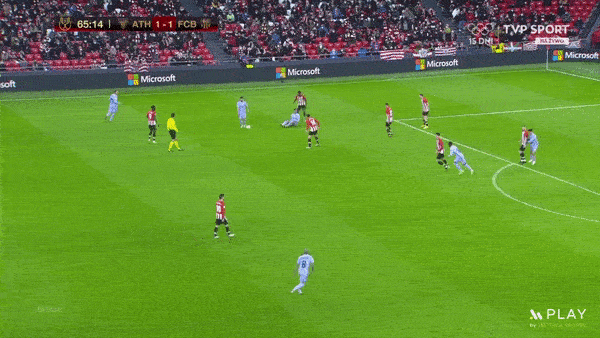
Notice that none of the passes are overly complex. Instead, Fati relies on the touch-and-move technique, opening and exploiting channels to aid progression. This is also where we can take a closer look at his first touch and control. Generally, he heavily prefers his right foot, regardless of the direction he’s intending to go in. This can be a disadvantage as using the back foot, which he doesn’t often do unless it’s his right, can ease his movement greatly.
Both controlling and passing are predominantly executed with his right foot too and the first touch can feel heavy in spite of the overall technical nature of the player. Similarly, Fati sometimes takes too many touches to control and progress the pass, leaving him open to interceptions and challenges. One thing we’ll notice, however, is that he usually checks away first, creating separation and showing for the ball at the appropriate time to receive cleanly.
This will aid him greatly in highly congested central areas, as will taking the first touch towards the pass. But the sequence above is a great representation of all of his associative traits and movement tendencies, both of which are fundamental aspects of a player with the capacity to transition into a centre-forward role.
However, it’s precisely that involvement in central spaces and highly marked scenarios we’ll use as a proxy for our analysis. Back-to-goal play is essential and good back-to-goal play is a combination of both physical and technical traits of the player. Physically as in how you use your frame to protect the ball and technically how you control (foot, angle, quantity/quality of touches), awareness of your surroundings, decision-making and timing when to peel away and when to run into space - all of those are aspects that need to be considered.
Some aspects that need to be analysed when dissecting back to goal play include but are not limited to the timing of showing for the ball, use of the back foot, the timing of peeling away from the marker, the quality of the first touch and quantity of touches needed to advance play, scanning to recognise the space to check away into and body orientation when receiving. The physical part, as alluded to, is also very important. Does the player possess the physical traits to not get dominated by the defenders? Can he use his frame well to protect the ball?
In the next four GIF examples, I want to demonstrate some of these traits in Fati.

Let’s touch on physicality and the use of his frame to protect the ball. The above sequence is a good demonstration of exactly that but also shows us some of the other aspects we’ve discussed. Notice Fati checks away from the marker first, timing well when to show for the ball. Upon receiving, he uses his back foot (left) to control and immediately turns to progress.
When José Giménez follows and engages in a duel, Fati uses his hand and body well to protect the ball and then beats the defender with a great dribble. We see him shrug off defenders for a bit longer before linking up and eventually getting knocked down, resulting in a free-kick in a dangerous area.
But that isn’t an isolated case either. The next GIF will show us a similar example, this time against Athletic Club.
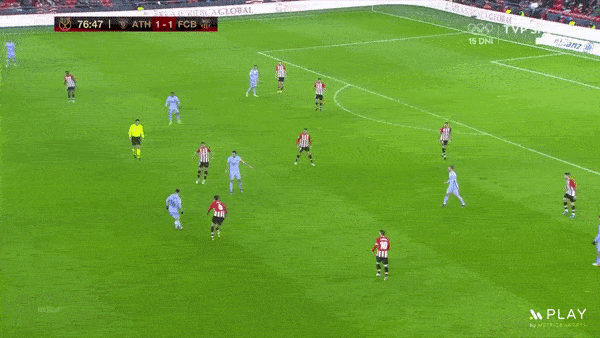
Again, here, we see Fati using his frame well to protect the ball and then sending a great lofted pass towards the right flank. While this isn’t back-to-goal play, it’s still receiving passes with immediate pressure from the back, which can give both us and Fati a taste of what’s to come if he was to transition to a centre-forward role.
The following example will be quite similar too. This time, Fati receives in the half-space and immediately engages in a duel with a player of greater physique than himself. But that doesn’t bother him too much as he stays strong on his feet before attempting to link up with his teammate higher up the pitch.
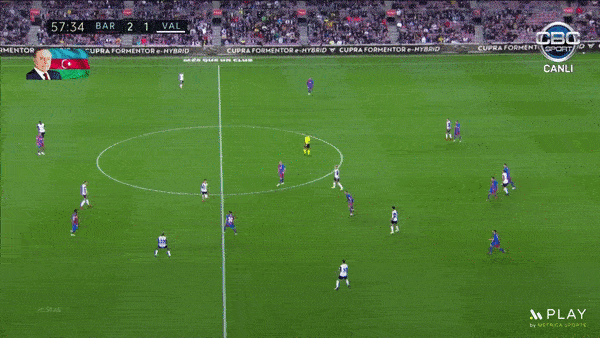
Once again we see him control with his back foot, which allows him to burst into a run much faster and more efficiently. But it’s the athleticism he shows next that’s very impressive. However, this isn’t always the case and at times, Fati will falter in scenarios similar to this one, showing there’s still room for improvement.
Our last example will be a lost possession in a back-to-goal situation. Fati controls with his right but then goes into traffic until he’s eventually muscled off the ball.
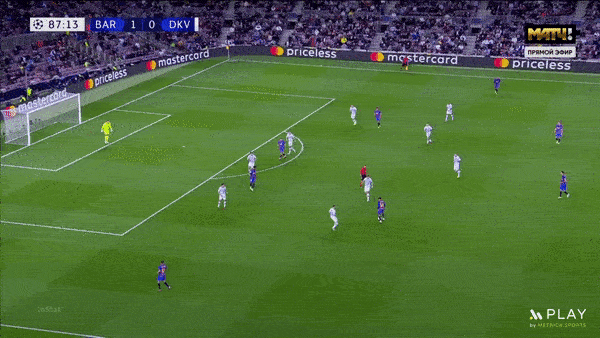
Had he scanned for other channels, this could’ve been a much cleaner check away into space to his right. Similarly, playing the ball first-time here could’ve been a better solution too. As mentioned, Fati sometimes takes too many touches and will want to carry the ball himself. Often, it leads to successful progression but it’s not the ideal solution for every scenario.
Poaching and ball-striking
The final aspects I want to discuss in this piece are poaching (movement inside the box) and ball-striking technique. We know Ansu is a lethal finisher but this comes as a result of several different key elements being combined. As with everything in our analysis, these core elements are all interconnected and work better in unison than as isolated principles. Movement is key but movement combined with a great ball-striking technique makes for elite poaching.
For the purpose of this article, I’ve analysed Fati’s last 48 shots to dissect his shooting technique, areas of occupation as well as pure ball-striking ability. Generally, ball-striking is very difficult to quantify. Players who can cleanly strike through the ball are classified as having good technique but that, too, is just one piece of the equation. Good ball-strikers consistently convert low expected goals (xG) chances, are good at set-pieces and long shots, and possess precision when passing over long distances. I’ve found Fati to be good at some but not necessarily all of those aspects.
We simply haven’t seen him on set-piece duty as much and his passing, although sound, is not as diverse or necessarily extraordinary. However, he’s a very good finisher who shoots with power and precision, which is important. In his last 48 shots, 30 were taken with the top of his foot, 16 with the inside of the foot, one with the outside and one with the head. This isn’t surprising for someone who strikes through the ball, as mentioned earlier. And on a similar note, 26 out of those 48 shots have been on target as well.
Digging a bit deeper, we can see some poaching elements but also some signature Fati aspects. For instance, 29 shots were taken after two or more touches, scoring four goals from 12 shots on target. 17, however, were taken after a single touch, scoring an impressive seven goals from 14 shots on targets. These attempts were also taken from more central areas of the box - quite telling already. But what about the quality of those shots?
16 shots had an xG value of 0.2 or higher, scoring six goals from 12 such shots on target. This signals efficiency in getting into the right positions to optimise goal-scoring opportunities, similarly to what Torres does too. On the other hand, 32 shots had an xG value of less than 0.2, resulting in five goals (three from outside the box) from 14 shots on target (six outside the box, including three goals). This tells us a lot about Fati’s ball-striking ability.
But a lot of that is due to his intelligent positioning inside the box, creating separation through subtle changes of direction or stalling of movement. Take the following sequence, for example.
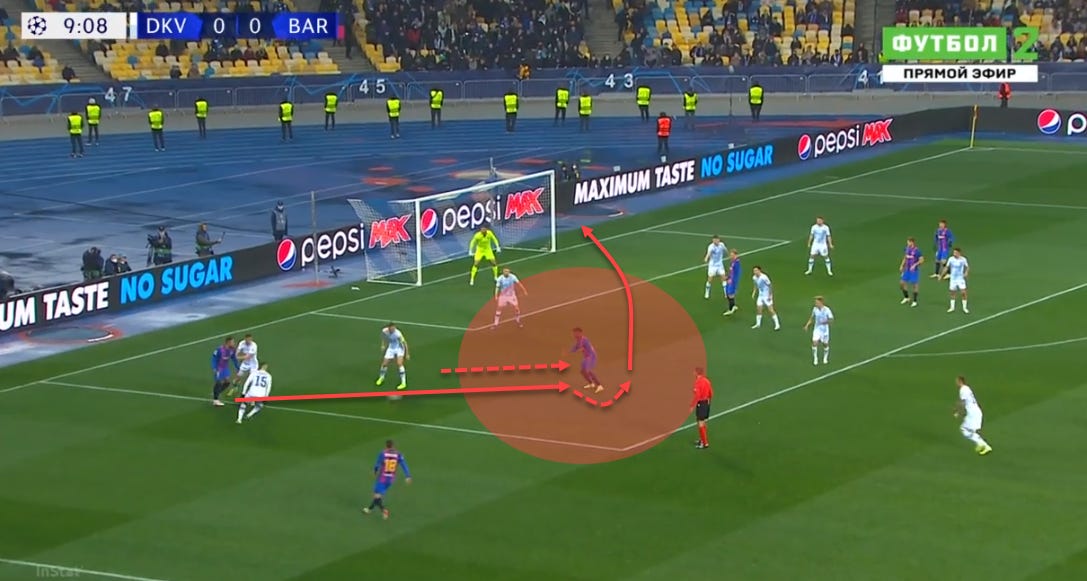
While this doesn’t end in a goal, the example still shows us how Fati moved a couple of steps backwards to create separation and enough space, buying the time to turn and take a shot. Elite strikers often do this to trick the defenders, moving in the opposite direction to escape their line of sight.
In this instance, Fati started moving backwards to create the separation but sometimes, that’s not an option. Instead, forwards often slow down or stall their movement completely to create space for themselves. Fati can already do this extremely well, as we’ll see in the following GIF example.
Here, against Real Madrid of all teams, Fati tricks the defender with his relaxed demeanour, giving the impression of an uninvolved attacker. But as soon as he gets more space, he springs a couple of steps forward and receives the ball for a first-time shot on target.
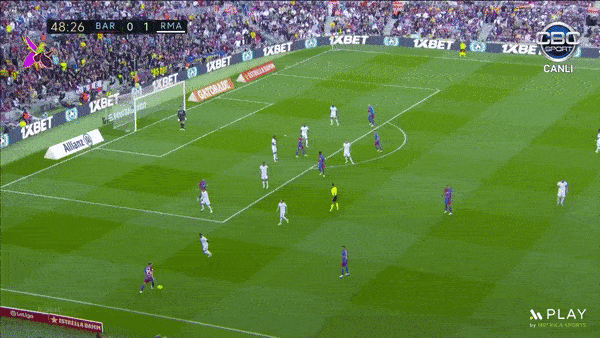
Of course, the defence needs to do better in this situation, especially since they were well aware of the player moving in that area. However, it’s the subtle movement that ultimately helps Fati get into so much space and take the shot off. Another very useful tool in such situations is the quick change of direction, which works similarly to the one just analysed.
In the Ferran Torres piece, I’ve talked about the importance of gaining the inside track on defenders as being a staple of elite strikers’ tool kit. Fati, too, possesses that trait and uses it quite well. Here’s an example down below.

And this is a proper poacher’s movement as well. Fati curves his run to get in front of the defender, times his jump perfectly and connects with a brilliant header to score the goal. All of these aspects are key and mastering them all makes one a formidable forward.
The final example I want to show you is a GIF of this subtle change of direction we’ve been discussing. This time, Fati is bursting into the box from a wide left position but instead of running in a straight line, he does a slight feint to bypass the defender and get to the ball in the centre.
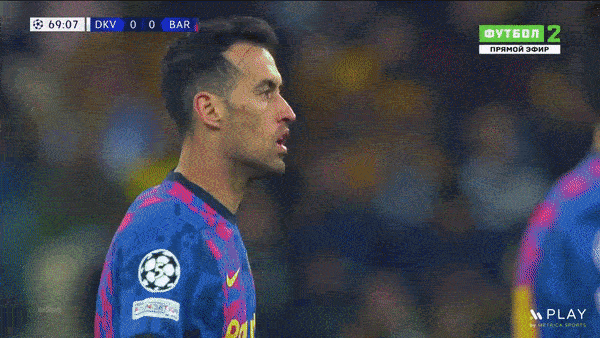
The finish, of course, is exquisite too. Fati combines power with precision and fires an unstoppable thunderbolt to take Barcelona 1:0 up against their European rivals. This sort of movement combined with an incredible finishing technique is what makes elite strikers elite.
And Fati has it in abundance.
Final remarks
In all likelihood, Barcelona will still chase a marquee number 9 signing this summer. There is nothing inherently wrong with that but seeing Fati in that role would be an exhilarating experiment with potentially game-changing results.
Of course, just having him back to full fitness, whether that’s as a left-winger or a striker, will be a huge boost to Xavi’s project. His lethality, movement, awareness and technique will make a difference no matter what position he’s deployed in and will definitely make Barcelona that much stronger.
So let’s hope he leaves his injury woes far behind him, for Blaugrana’s and football’s sake alike.

